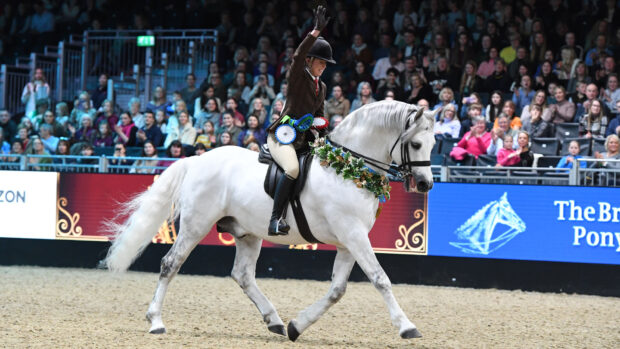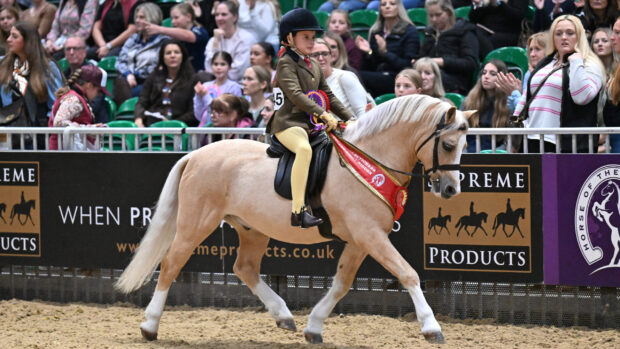The Dartmoor pony is the native breed of the county of Devon in the south west of England. The ponies have been recorded living on the moors of Dartmoor since the middle ages, meaning they have developed to be hardy and resilient. They cannot exceed 12.2hh and can be bay, brown, black, grey, chestnut, roan. Piebalds, skewbalds and spotted ponies are not allowed.
The Dartmoor Pony Society (DPS) represents the pedigree Dartmoor pony, but there are many ponies living out on Dartmoor of all sizes and colours, most of unknown breeding. These are typically described as Dartmoor Hill Ponies.
The DPS states that: “The true-to-type Dartmoor Pony with known breeding is recognised as a rare breed by the Rare Breeds Survival Trust and is typical of the ponies seen in the show ring at county shows throughout the United Kingdom.”
The breed standard of the Dartmoor Pony is as follows:
Colour: A certain amount of white is and always has been acceptable. Excessive white markings to be discouraged. (e.g. Acceptable – small sock to fetlock, small star or snip. Not Acceptable – White blaze, stripe and any stockings)
Neck and head: The head is small and bloodlike, reasonably short from eye to muzzle and without much tapering to the nose. The ears are small and alert and the eyes fairly large giving the pony a kindly interested expression. It should be well set on a good neck of medium length. The throat and jaws should be fine and showing no signs of coarseness or throatiness. Stallions to have a moderate crest.
Shoulders: Good shoulders are most important. They should be well laid back and sloping, but not too fine at the withers.
Body: Of medium length and strong, well ribbed up with a good depth of girth giving plenty of heart room.
Loin and hindquarters: Strong and well covered with muscle. The hind quarters should be of medium length and neither level nor steeply sloping. The tail is well set up.
Limbs: The forelegs should not be tied in at the knee. The fore-arm should be muscular and relatively long and the knee fairly large and flat at the front. The cannons should be short with ample good, flat bone. The pasterns should be sloping but not too long. The feet should be hard and well shaped. The hocks should be well let down with plenty of length from hip to hock, clean cut and with plenty of bone below the hock. They should have a strong second thigh. They should not be sickled or cow-hocked.
Movement: Low and straight coming from the shoulder with good hock action but without exaggeration.
The breed standard also states that the Dartmoor makes a very good looking riding pony, and should be sturdily built yet with quality, like a scaled down middleweight hunter. The mane and tail should be full and flowing. The general impression given by a Dartmoor is of a well made, quality pony with ample bone which stands over plenty of ground.
The DPS has a grading system for stallions which can become premium or super premium through the progeny they have sired winning at the society’s star shows.
Dartmoor ponies were originally used to carry tin from the mines, for farm work and as pack-horses for transporting goods.
In the 1920s, Prince Edward (Edward VIII) kept and bred Dartmoor ponies near Princetown and crossed them with Arab ponies with the aim of producing a finer polo pony. Dartmoor ponies were originally recorded in the Polo Pony Society Stud Book, then in the stud books of the National Pony Society from 1898 and then in 1924 the DPS was created and took over the maintenance of the stud book.
The Dartmoor is listed as a rare breed as there are less than 1,000 breeding mares remaining.
Today, the Dartmoor pony is seen as an excellent child’s pony, although they are also ridden by small adults.

In 2010 and 2011, two Dartmoor ponies consecutively landed the Olympia M&M supreme title. The 2010 champion was Sue Hughes’ black stallion Pumphill Buckthorn (above) who had won the overall M&M ridden pony of the year title at HOYS three months before. The following year, Christine Anderson’s bay stallion Rushfield Bailey was crowned champion.
For all the latest equestrian news and reports, don’t miss Horse & Hound magazine, out every Thursday



